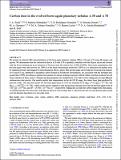Por favor, use este identificador para citar o enlazar a este item:
http://hdl.handle.net/10261/247831COMPARTIR / EXPORTAR:
 SHARE SHARE
 CORE
BASE CORE
BASE
|
|
| Visualizar otros formatos: MARC | Dublin Core | RDF | ORE | MODS | METS | DIDL | DATACITE | |

| Título: | Carbon dust in the evolved born-again planetary nebulae A 30 and A 78 |
Autor: | Toalá, J. A.; Jiménez-Hernández, P.; Rodríguez-González, J. B.; Estrada-Dorado, S.; Guerrero, Martín A. CSIC ORCID; Gómez-González, V. M. A.; Ramos-Larios, G.; García-Hernández, D. A.; Todt, H. | Palabras clave: | Stars: evolution Stars: winds, outflows ISM: molecules Planetary nebulae: individual: A 30, A 58, A 78 Infrared: ISM |
Fecha de publicación: | may-2021 | Editor: | Oxford University Press | Citación: | Monthly Notices of the Royal Astronomical Society 503(1): 1543-1556 (2021) | Resumen: | We present an infrared (IR) characterization of the born-again planetary nebulae (PNe) A 30 and A 78 using IR images and spectra. We demonstrate that the carbon-rich dust in A 30 and A 78 is spatially coincident with the H-poor ejecta and coexists with hot X-ray-emitting gas up to distances of 50 arcsec from the central stars of PNe (CSPNe). Dust forms immediately after the born-again event and survives for 1000 yr in the harsh environment around the CSPN as it is destroyed and pushed away by radiation pressure and dragged by hydrodynamical effects. Spitzer IRS spectral maps showed that the broad spectral features at 6.4 and 8.0 μm, attributed to amorphous carbon formed in H-deficient environments, are associated with the disrupted disc around their CSPN, providing an optimal environment for charge exchange reactions with the stellar wind that produces the soft X-ray emission of these sources. Nebular and dust properties are modelled for A 30 with cloudy taking into account different carbonaceous dust species. Our models predict dust temperatures in the 40-230 K range, five times lower than predicted by previous works. Gas and dust masses for the born-again ejecta in A 30 are estimated to be Mgas=4.41+0.550.14× 10-3 M· and M dust=3.20+3.21-2.06× 10-3 M·, which can be used to estimate a total ejected mass and mass-loss rate for the born-again event of 7.61+3.76-2.20× 10-3 M· and M=(5-60)× 10-5 M· yr-1, respectively. Taking into account the carbon trapped into dust grains, we estimate that the C/O mass ratio of the H-poor ejecta of A 30 is larger than 1, which favours the very late thermal pulse model over the alternate hypothesis of a nova-like event. © 2021 The Author(s). | Versión del editor: | http://dx.doi.org/10.1093/mnras/stab593 | URI: | http://hdl.handle.net/10261/247831 | DOI: | 10.1093/mnras/stab593 | ISSN: | 0035-8711 | E-ISSN: | 1365-2966 |
| Aparece en las colecciones: | (IAA) Artículos |
Ficheros en este ítem:
| Fichero | Descripción | Tamaño | Formato | |
|---|---|---|---|---|
| 2021MNRAS.503.1543T.pdf | 6,88 MB | Adobe PDF |  Visualizar/Abrir |
CORE Recommender
SCOPUSTM
Citations
12
checked on 12-may-2024
WEB OF SCIENCETM
Citations
8
checked on 25-feb-2024
Page view(s)
75
checked on 20-may-2024
Download(s)
67
checked on 20-may-2024
Google ScholarTM
Check
Altmetric
Altmetric
NOTA: Los ítems de Digital.CSIC están protegidos por copyright, con todos los derechos reservados, a menos que se indique lo contrario.
